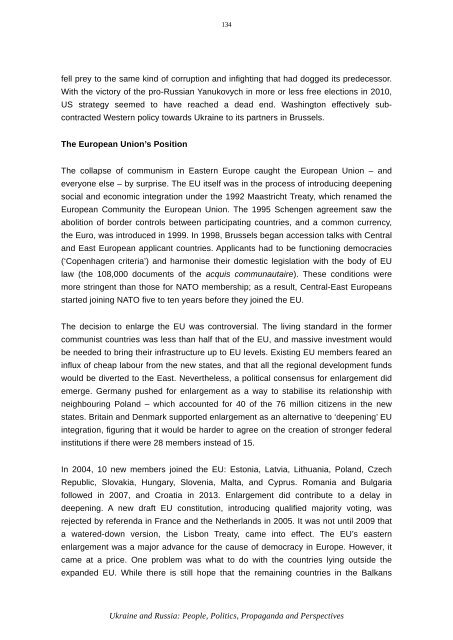Ukraine-and-Russia-E-IR
Ukraine-and-Russia-E-IR
Ukraine-and-Russia-E-IR
Create successful ePaper yourself
Turn your PDF publications into a flip-book with our unique Google optimized e-Paper software.
134<br />
fell prey to the same kind of corruption <strong>and</strong> infighting that had dogged its predecessor.<br />
With the victory of the pro-<strong>Russia</strong>n Yanukovych in more or less free elections in 2010,<br />
US strategy seemed to have reached a dead end. Washington effectively subcontracted<br />
Western policy towards <strong>Ukraine</strong> to its partners in Brussels.<br />
The European Union’s Position<br />
The collapse of communism in Eastern Europe caught the European Union – <strong>and</strong><br />
everyone else – by surprise. The EU itself was in the process of introducing deepening<br />
social <strong>and</strong> economic integration under the 1992 Maastricht Treaty, which renamed the<br />
European Community the European Union. The 1995 Schengen agreement saw the<br />
abolition of border controls between participating countries, <strong>and</strong> a common currency,<br />
the Euro, was introduced in 1999. In 1998, Brussels began accession talks with Central<br />
<strong>and</strong> East European applicant countries. Applicants had to be functioning democracies<br />
(‘Copenhagen criteria’) <strong>and</strong> harmonise their domestic legislation with the body of EU<br />
law (the 108,000 documents of the acquis communautaire). These conditions were<br />
more stringent than those for NATO membership; as a result, Central-East Europeans<br />
started joining NATO five to ten years before they joined the EU.<br />
The decision to enlarge the EU was controversial. The living st<strong>and</strong>ard in the former<br />
communist countries was less than half that of the EU, <strong>and</strong> massive investment would<br />
be needed to bring their infrastructure up to EU levels. Existing EU members feared an<br />
influx of cheap labour from the new states, <strong>and</strong> that all the regional development funds<br />
would be diverted to the East. Nevertheless, a political consensus for enlargement did<br />
emerge. Germany pushed for enlargement as a way to stabilise its relationship with<br />
neighbouring Pol<strong>and</strong> – which accounted for 40 of the 76 million citizens in the new<br />
states. Britain <strong>and</strong> Denmark supported enlargement as an alternative to ‘deepening’ EU<br />
integration, figuring that it would be harder to agree on the creation of stronger federal<br />
institutions if there were 28 members instead of 15.<br />
In 2004, 10 new members joined the EU: Estonia, Latvia, Lithuania, Pol<strong>and</strong>, Czech<br />
Republic, Slovakia, Hungary, Slovenia, Malta, <strong>and</strong> Cyprus. Romania <strong>and</strong> Bulgaria<br />
followed in 2007, <strong>and</strong> Croatia in 2013. Enlargement did contribute to a delay in<br />
deepening. A new draft EU constitution, introducing qualified majority voting, was<br />
rejected by referenda in France <strong>and</strong> the Netherl<strong>and</strong>s in 2005. It was not until 2009 that<br />
a watered-down version, the Lisbon Treaty, came into effect. The EU’s eastern<br />
enlargement was a major advance for the cause of democracy in Europe. However, it<br />
came at a price. One problem was what to do with the countries lying outside the<br />
exp<strong>and</strong>ed EU. While there is still hope that the remaining countries in the Balkans<br />
<strong>Ukraine</strong> <strong>and</strong> <strong>Russia</strong>: People, Politics, Propag<strong>and</strong>a <strong>and</strong> Perspectives


